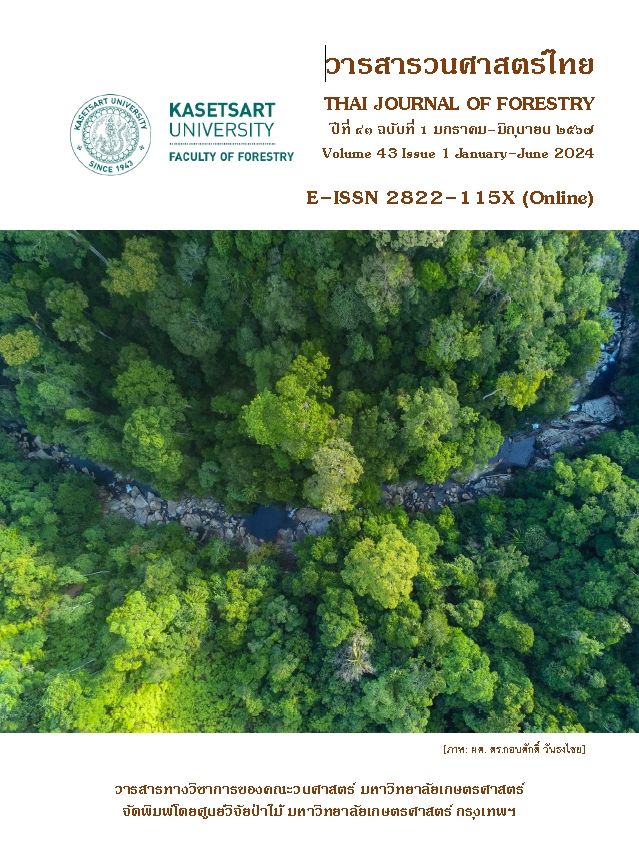การวิเคราะห์ปัจจัยในการเลือกพื้นที่ที่เหมาะสมในการติดตั้งกล้องดักถ่ายภาพอัตโนมัติ ระบบเอ็นแคป: กรณีศึกษาพื้นที่อุทยานแห่งชาติแม่วงก์ จังหวัดกำแพงเพชร
Main Article Content
บทคัดย่อ
ทรัพยากรธรรมชาติป่าไม้และสัตว์ป่ามีแนวโน้มลดลงอย่างมาก เนื่องจากสาเหตุสำคัญหลายประการ ได้แก่ การบุกรุกลักลอบตัดไม้ทำลายป่า ล่าสัตว์ป่า เป็นต้น ปัจจุบันได้มีการพัฒนานำเทคโนโลยีสมัยใหม่เข้ามาปรับใช้แก้ไขปัญหา คือ ระบบเฝ้าระวังการกระทำผิดกฎหมายด้วยการป่าไม้หรือที่เรียกว่า ระบบเอ็นแคป (network centric anti-poaching system, NCAPS) การศึกษาครั้งนี้มีวัตถุประสงค์เพื่อการวิเคราะห์ปัจจัยในการเลือกพื้นที่ที่เหมาะสมในการติดตั้งกล้องดักถ่ายภาพอัตโนมัติระบบเอ็นแคป ประกอบด้วย 8 ปัจจัย ได้แก่ ความสูงของพื้นที่ ความลาดชัน ระยะห่างจากแหล่งชุมชน ระยะห่างจากถนน ระยะห่างจากแม่น้ำ ระยะห่างจากหน่วยพิทักษ์ป่า ระยะห่างจากโป่ง และขอบเขตสัญญาณโทรศัพท์เคลื่อนที่ ด้วยวิธีกระบวนการวิเคราะห์ตามลำดับชั้น (AHP) โดยการเปรียบเทียบความสำคัญของปัจจัยที่มีอิทธิพลต่อการติดตั้งกล้องดักถ่ายภาพอัตโนมัติระบบเอ็นแคปทีละคู่ จากการให้ค่าคะแนนของผู้เชี่ยวชาญ และวิเคราะห์พื้นที่เหมาะสมในการติดตั้งกล้องดักถ่ายภาพอัตโนมัติระบบเอ็นแคป ผลการศึกษาพบว่าปัจจัยที่มีค่าน้ำหนักคะแนนมากที่สุด คือ ปัจจัยขอบเขตสัญญาณโทรศัพท์เคลื่อนที่ มีค่าน้ำหนักคะแนนเท่ากับ 0.324 จากการซ้อนทับข้อมูลปัจจัยสามารถแสดงผลการวิเคราะห์พื้นที่ที่เหมาะสมในการติดตั้งกล้องดักถ่ายภาพอัตโนมัติระบบเอ็นแคปโดยแบ่งออกเป็น 5 ระดับ โดยระดับพื้นที่ที่เหมาะสมมากที่สุดในการติดตั้งกล้องดักถ่ายภาพอัตโนมัติระบบเอ็นแคปมีประมาณ 50.489 เฮกตาร์ คิดเป็นร้อยละ 0.055 ของพื้นที่ทั้งหมด ซึ่งจากการศึกษาพบว่าพื้นที่ที่เหมาะสมมากที่สุดในการติดตั้งกล้องดักถ่ายภาพอัตโนมัติระบบเอ็นแคป อยู่บริเวณตามแนวขอบเขตของอุทยานแห่งชาติแม่วงก์ที่ติดกับหมู่บ้านและถนน ผลการศึกษานี้สามารถนำไปใช้เป็นแนวทางการวางแผนพิจารณาการติดตั้งกล้องดักถ่ายภาพอัตโนมัติระบบเอ็นแคป โดยพิจารณาจากปัจจัยที่เหมาะสมในการติดตั้งเพื่อการป้องกันและการเฝ้าระวังการบุกรุกลักลอบตัดไม้ ล่าสัตว์ป่า และปัญหาสัตว์ป่าออกนอกพื้นที่ รวมทั้งปัจจัยคุกคามด้านอื่น ๆ และเป็นแผนการบริหารจัดการพื้นที่อุทยานแห่งชาติแม่วงก์อย่างยั่งยืนต่อไป
Downloads
Article Details

อนุญาตภายใต้เงื่อนไข Creative Commons Attribution-NonCommercial-NoDerivatives 4.0 International License.
ข้าพเจ้าและผู้เขียนร่วม (ถ้ามี) ขอรับรองว่า ต้นฉบับที่เสนอมานี้ยังไม่เคยได้รับการตีพิมพ์และไม่ได้อยู่ในระหว่างกระบวนการพิจารณาตีพิมพ์ลงในวารสารหรือสิ่งตีพิมพ์อื่นใด ข้าพเจ้าและผู้เขียนร่วม (ถ้ามี) ยอมรับหลักเกณฑ์และเงื่อนไขการพิจารณาต้นฉบับ ทั้งยินยอมให้กองบรรณาธิการมีสิทธิ์พิจารณาและตรวจแก้ต้นฉบับได้ตามที่เห็นสมควร พร้อมนี้ขอมอบลิขสิทธิ์ผลงานที่ได้รับการตีพิมพ์ให้แก่วารสารวนศาสตร์ คณะวนศาสตร์ มหาวิทยาลัยเกษตรศาสตร์ กรณีมีการฟ้องร้องเรื่องการละเมิดลิขสิทธิ์เกี่ยวกับภาพ กราฟ ข้อความส่วนใดส่วนหนึ่ง หรือ ข้อคิดเห็นที่ปรากฏในผลงาน ให้เป็นความรับผิดชอบของข้าพเจ้าและผู้เขียนร่วม (ถ้ามี) แต่เพียงฝ่ายเดียว และหากข้าพเจ้าและผู้เขียนร่วม (ถ้ามี) ประสงค์ถอนบทความในระหว่างกระบวนการพิจารณาของทางวารสาร ข้าพเจ้าและผู้เขียนร่วม (ถ้ามี) ยินดีรับผิดชอบค่าใช้จ่ายทั้งหมดที่เกิดขึ้นในกระบวนการพิจารณาบทความนั้น”
เอกสารอ้างอิง
Bhumpakphan, N. 2000. Wildlife Management. Kasetsart University, Bangkok, Thailand. (in Thai)
Department of National Parks, Wildlife and Plant Conservation. 2021. NCAPS. http://portal.dnp.go.th/Content?contentId=15506, 3 November 2022. (in Thai)
Engiz, B.K., Kurnaz, C. 2016. Comparison of signal strengths of 2G/3G/4G services on a university campus. International Journal of Applied Mathematics Electronics and Computers, 4(1): 37-42. doi: 10.18100/ijamec.270710.
Global Conservation. 2020. Umphang & Thung Yai. Thailand 2019-2020 Progress Report.https://globalconservation.org/news/umphang-thung-yai-2019-2020-progress-report/, 3 November 2022.
Jakjum, N. 2004. Application of GIS for Determining Risk Area for Encroachment of Phu Pan National Park, Sakon Nakhon Province. M.S. Thesis, Kasetsart University, Bangkok, Thailand. (in Thai)
Khiaosalab, P., Tongdeenok, P. 2015. Application techniques analytic hierarchy process and geographic information system comparison susceptible landslide area in Huai Mae Saroi Watershed, Phrae province and Khlong Tha Thon Watershed, Nakhon Si Thammarat province. KKU Research Journal (Graduate Studies), 15(1): 63-79. (in Thai)
Morakotkheaw, N. 2008. Application of Geographic Information System to Assess Risk Area of Encroachment at Phu Pha Man National Park, Changwat Khon Kaen. M.S. Thesis, Kasetsart University, Bangkok, Thailand. (in Thai)
Pansawang, C., Thanakasem, N., Amornwitthawat, P., Pannawong, S., Samanasena, P. 2017. The study of plant species diversity in nature-based attraction case study: Mae Wong National Park, Nakhonsawan province. In: Proceedings of the 5th National Academic Conference. Muban Chombueng Rajabhat University, Ratchaburi, Thailand, pp. 188-195. (in Thai)
Praphai, T. 2008. Application of Geo-Informatics for Assessment of Invasive Risk Prone Protected Area and the Surroundings of Kaeng Krachan National Park. M.S. Thesis, Kasetsart University, Bangkok, Thailand. (in Thai)
Riantrakool, L., Tiensing, T., Nguemnanchai, P., Songsaeng, N. 2022. Multi-criteria Analysis to determine the suitability for network centric anti-poaching system (NCAPS) installation. Thai Science and Technology Journal, 30(1): 186-199. (in Thai)
Royal Forest Department. 2021. Forest Area of Thailand in 1973–2021. https://knoema.com/atlas/Thailand/topics/Land-Use/Area/Forest-area, 20 October 2022.
Saaty, T.L. 1980. The Analytic Hierarchy Process. McGraw-Hill, New York, USA.
Sirilert, R., Saguantam, P. 2016. Application of geographic information system to determining risk area encroachment in Khuean Srinagarindra National Park, Kanchanaburi province. Journal of Forest Management, 10(19): 1-13. (in Thai)
Sonsab, T., Arunpraparut, W., Pongpatttananurak, N. 2018. Determination of forest encroachment risk in head Watershed at Doi Phu Kha National Park, Nan province. Thai Journal of Forestry, 37(2): 60-70. (in Thai)
Sukprasert, P. 2013. Awareness of the Conservation of Natural Tourism Resources of Thai Tourists in Mae Wong National Park. M.S. Thesis, Naresuan University, Phitsanulok, Thailand. (in Thai)
Tansirikongkol, V. 2014. Advanced Decision for Organization Progress and Public Well-being. Amarin Corporations Public Company Limited, Bangkok, Thailand. (in Thai)
Trisurat, Y. 2003. Ecosystem-based management zones of the western forest complex, Thailand. In: Proceedings of the 5th International SAMPAA Conference. Thailand, pp. 10. (in Thai)
Wangkeeree, P., Rianthakool, L., Arunpraparut, W. 2021. Application of geographic information system in the analysis of areas at risk from encroachment at the Phu Koh–Phu Kratae Wildlife Sanctuary, Loei province. Thai Journal of Forestry, 40(1): 34-49. (in Thai)
Wannasatid, W., Sukmasuang, R., Sunthornhao, P. 2020. Public opinion to the human and wild elephant conflicts mitigation, Khao Ang Rue Nai Wildlife Sanctuary in Kaeng Hang - Maeo district, Chanthaburi province. Rajabhat Rambhai Barni Research Journal, 14(2): 160-169. (in Thai)
Wildlife Conservation Society. 2021. SMART Patrol Technique for Protected Area Management. https://thailand.wcs.org/th-th/Initiatives/Smart-Patrol-System.aspx, 16 March 2023.
Wiratphinthu, S., Kansorn, E. 2015. A survey of bird diversity in lower montane forest in Mae Wong National Park, Kamphaeng Phet province. In: Proceedings of the 5th Thai Forest Ecological Research Network Conference. Faculty of Forestry, Kasetsart University, Bangkok, Thailand, pp. 223-228. (in Thai)


